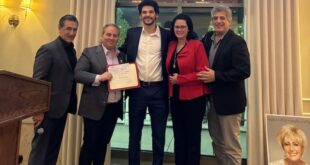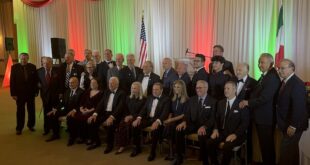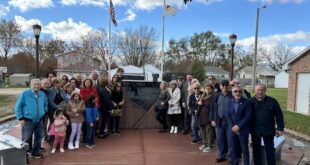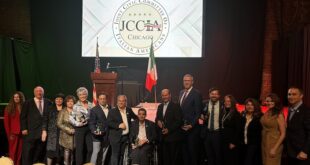by Lionel Bottari
When budding young actors and actresses look for inspiration in that mother of all improvised comedy, Commedia dell’Arte, it is inevitable that they will come upon the name and works of Maestro Antonio Fava. In giving this author of “The Comic Mask in the Commedia dell’Arte” (Northwestern University Press), master artisan of the leather half-mask, and teacher of traditional improvised theater it’s hospitality, Casa Italia joined the ranks of world-class cultural institutions that invites Italian artists to work and stay as artists in residence.
The Maestro was invited to come as an artist in residence by the Casa and the Calabresi in America Organization. While here, he dedicated himself to research for his next book at the Casa library and gave a presentation on May 12.
This was part lecture and part performance, which the Maestro began with a fairly long talk. While interesting from a historical and scholarly perspective, it also served another, more theatrical function. Speaking in English to his unsuspecting audience, he ably put them into a relaxed state. Then he launched into a vigorous performance in Italian using the power of his facial expressions and his physical theater skills to leap the language barrier.
One of the truly unique things about Antonio Fava is that he comes out of the folk tradition of the Calabrian Pulcinella from his own family. This “personaggio” was more than a character, it was a storyteller, a version of “cantastorie” that could take on several roles.
To demonstrate this tradition, Fava’s body went slack, his head went back, and his mouth fell open. He had transformed himself into an very old man who was falling asleep. Then he took a few steps to the other side of the tiny stage, hunched over like a chipmunk, flattened the features of his face and started knitting. He looked for all the world like an old woman.
Then this old “grandmother” glanced up and said: “piddicchius’.”
Stepping back over to the other side of the stage, he became the old man waking up slowly and shaking his head. Gradually the character became aware that he’d just been insulted.
“Che dici? Piddicchius’? Chi e’ piddicchius’?”
Fava became the old woman again, knitting away silently for a time, then, looking pointedly in the direction of her husband said:
“Tu, sei tu piddicchius’!”
The elderly man’s face changed into a combination of senility and rage.
“Io! Io piddicchuis’! Taci o ti butto nel pozzo!” He slowly rose up, an old man full of rage and menace. But his wife wasn’t done with him.
“Piddicchius’!” hissed the old woman to his face.
Then, to the amazement of the audience, Maestro Fava as the old man threw Maestro Fava as the old woman into the well. Down she went, feet first, her arms over her head, her faced puffed and her eyes squeezed shut.
“Ora, ora, dimmi chi e’ piddicchius’!” shouted the old man, looking down into the well at his drowning wife. Her left arm, extended straight up, reached down into her hair and picked something out, and she pointed at it with her other hand. Then she straightened her right arm up and pointed up at him, shaking her finger.
It took a while before the audience could stop laughing.
This audience was very mixed, and it was clear that many up them did not understand Italian, let alone words in the dialect of southern Calabria. Yet no explanation that “piddicchius'” (louse ridden) was a terrible insult was needed. The “black mime” performance of Maestro Fava was so on the mark that all, whatever their background, got it.
In the lecture that preceded the several other performances he gave, the Maestro talked about his own theories of the genesis of the Commedia dell’Arte. He believed that itinerant performers, not unlike the succession of Calabrian Pulcinelle in his own family, performed to make money. This determined what worked from a financial perspective, creating the “job” of the Commedia actor as a profession. These days, very few are able to support themselves as professional Commedia actors; Maestro Antonio Fava is one of those few.
Moving into a discussion of the origins of the Commedia characters that came to symbolize the regions from which they came, the Maestro pointed out that each one came armed with his own language. The idea that Italy has dialects is inaccurate, he asserted. In fact, Italy has languages, each with distinct origins and a literature and poetry all its own. The characters that appeared in the plays always featured one “personaggio” that was local, and so that person served as an interpreter, creating the first truly “national” theater in Italy.
Then Maestro Fava, speaking only in Italian at this point, illustrated the regions of Italy with the parts of his own body. Each one offered its complaints in its dialect, until he reached southern Calabria, the sole of his right foot. Hobbling around the stage, he behaved as if it was in great pain. Symbolic, perhaps, of the “disprezzo,” or disrespect, persons whose origins lie south of Rome are afflicted with by their more northern brothers in that oddly divisive motherland of ours.
A video of Maestro Fava’s performance will be available at the library in the Italian Cultural Center at Casa Italia in the near future.
For details, call 708-345-5933 or e-mail icc_djm@yahoo.com.
 Fra Noi Embrace Your Inner Italian
Fra Noi Embrace Your Inner Italian












